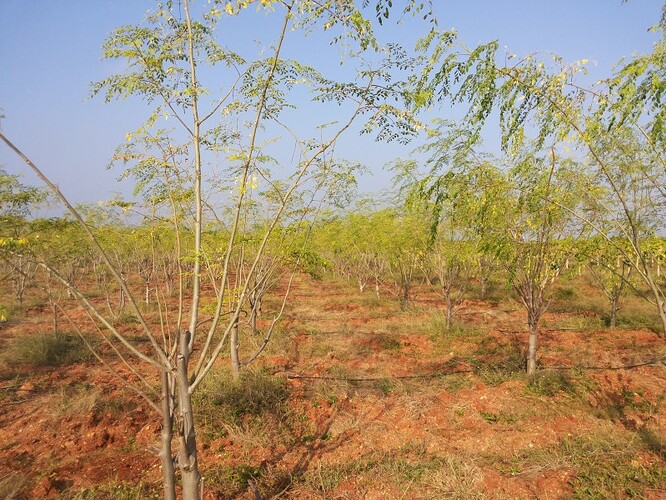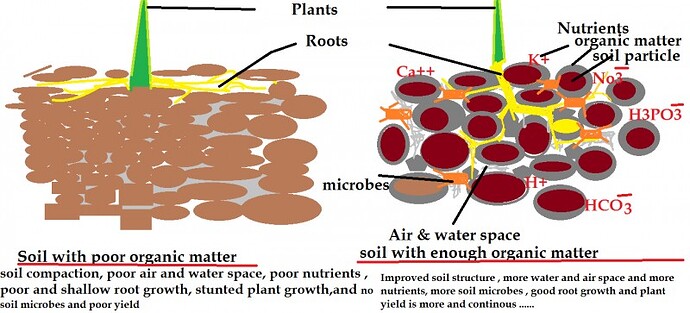Repeated pruning to induce more branching and side shoots , 10 kgs of FYM for each tree and 400 grams of Ammonium sulphate triggers more flowers and treble the pods yield in moringa
Dear Ramu,
Just a clarification. Is it 400 gms of Ammonium sulphate per plant? Is there any less expensive alternative to Ammonium Sulphate? Please advise.
Thanks & Regards
Guru Prasad
Hiriyur
+91 9620944466
Dear Mr.Prasad …
Yes it is 400 grams of Ammonium sulphate per plant …I dont think there is any alternative to ammonium sulphate but you can try equivalent chemicals …In case of improved moringa plants that is high yielder this method is advised for induction of profuse flowering…Since you say you are from Bellary district that is one of the vegetable belt in India you would have gained lot of knowledge about high yielding hybrid vegetable cultivation and yield parameters…Since basically the moringa plants are cross pollinated crops and the seeds produced for subsequent cultivation might have varying potential to generate adequate flowering , this combination of Ammonium sultphate plus FYM was tried and resulted in profuse flowering in annual moringa …best of luck …
Regards
T.Ramu
chennai
Thanks for the info sir.
I have pruned my moringa after 1st harvest a month ago.
When is the best time to apply ammonium sulphate i.e., in single dose now @400gms/plant or in split doses?
If split doses, at what stages/intervals of plant growth? Kindly advise.
Thanks & Regards
Guru Prasad
Hiriyur
+91 9620944466
guru.3112@gmail.com
Dear Guru
You can start applying Ammonium sulphate in 3 or 4 split doses from 5 th month onwards …Since the moringa keeps flowering continuously the split dose along with dry powdered farm yard manure will be best …As I earlier advised about regular and repeated pruning depending upon plant growth and intensity of flowering , you can apply after every pruning …
Regards
Ramu
Dear Friends,
Due to continuous rains in the past 20 days, 70% of the flowers of drumstick plant have dropped. Plants health seem to be fine if not best. Now the sun is bright from the past 3 days. Please share your experience if the moringa trees would bear flowers again if I continue to give manures & fertilizers. Should I use any flower booster medicine? Or should I cut down the trees to 3 feet if there are less chances of flowering? Kindly advise.
Also attaching couple of pictures. Please advise if they are suffering from any deficiency or disease.
Thanks & Regards
Guru Prasad
Hiriyur, Karnataka
guru.3112@gmail.com
+919 9620944466
My 1000 PKM-1 Drumstick plants are in 2nd month, applied FYM and 50gm of complex fertilizer per plant, what cultural practices I have to take up now, now they are 2ft height, when to take up nipping. Kindly reply.
I want to plant another 1000 plants of the same hybrid, is this is a right time to plant, if so where better qualiry seedlings available.
I confirm it. Adding Ammonium Sulphate to Moringa plants increased the yield significantly.
Rather than giving all 400g at once, we are giving 50g each week. Please let me know what is the best and most-yielding process.
Thanks.
In what way are you providing the fertilizer? Drip or soil application?
Nikhil
Dear Sri Nikhil ,
Ammonium sulphate is very much water soluble and it can be given to drip through ventury. It can also be soil application, but results will be fast with drip and easy process.
With best wishes , g.p.rao, farmer
Dear friends,
My moringa trees are into their 4th season. This time the pods are shorter about 1 to 1.3 feet and lacks flesh. The appearance is dull & is not very pleasing. I could not give much fertilizer & required water during the growth. I did regular pruning and the branching is good i.e., 5 to 8 branches per tree.
Now that the trees are producing pods, is there any way of a quick-fix to make the pods grow a bit lengthier & with better flesh? I know it is not quite reasonable to expect good yield without having done my homework properly but curious to know just in case if there is any remedy.
Thanks & regards
Guru
Dear Guru sir, does moringa annual varrty get pollinated due to wind or presence of bees required??
Dear Vaishak,
The pollination in my field was mostly due to bees. What I observed is that there were lots of weeds whose flowering coincided with that of moringa and so the bees which initially came for flowers of weeds also pollinated moringa flowers I guess.
Also I see that the pods are developing red color stripes this time. Not able to figure out what could be the reason. Would be thankful if anyone can help me in this regard.
Thanks & Regards
Guru
Dear pal
The tan colored pods appear so either due to insect damage called Pod fly or due to water stress that is caused by soil compaction in red lateritic soil with poor moisture and water holding capacity …
Further you said you moringa plantation is running into 4 th year …So the conducting tissue called Xylem vessels that takes and transport water and nutrients from soil to distant plant canopy would have gone sclerotic and old enough to pull sufficient water to where the branch produce flowers and pods .so we need to replant moringa atleast after second crop …
Dear rao sir, ramu sir,
I have planted one feet moringa pkm 1 variety in November 2015 ( 40 plants) on trial basis… Some of the trees have grown 8 feet to 13 feet note as if today. But there is no flowering yet. My farm is 12 km from udupi. Pls suggest. I thought it should have been flowering by now since already 7-8 months from transplanting. Pls help and guide. Thanks regards.
Dear rao sir, ramu sir,
I have planted one feet moringa pkm 1 variety in November 2015 ( 40 plants) on trial basis… Some of the trees have grown 8 feet to 13 feet note as if today. But there is no flowering yet. My farm is 12 km from udupi. Pls suggest. I thought it should have been flowering by now since already 7-8 months from transplanting. Pls help and guide. Thanks regards.
hello
Coming back to the topic,
vaishak,
I think there is something wrong if your plants have reached that height in 7 months. You have to restrice height to 6-7 feet for the complete duration of the crop. That is the only way you will get good yield and flowring.
have you pruned the plants? If not it would better to prune the branches asap and then see the flowers emerge.
Good luck. Some photos always helps in understanding the problem.
Nikhil
Dear Mr.Vishak…
The PKM-1 Drumstick is a short stature character . The Horticulture Research station at Periyakulam developed this particular variety after a long trial that involved selection from moringa plants grown along the western ghat area .
The PKM-1 that were grown widely over varied climatic conditions in India as well as other Asian and African countries reported variation in the flowering pattern …
Some places notice flowering in two season say February - May and September- November and some other places notice flowering continuously…
Flowering starts in about 150-180 days after sowing …
However the field observation in various location confirms influence of climate and soil on early or late flowering in Moringa …
Hence sowing time needs to be adjusted in case of moringa planting/ sowing …
In india particularly we experience only 2 season namely long summer ( March- November - 9 months period ) and short winter ( December-February - 3 months ) and in North India it is hot summer and cold winter …
So we are choosing June 2nd fortnight for planting moringa …The moringa grows well during South west monsoon the onset of which coincide with sowing of seeds or seedlings in south India …The moringa grows through summer and produce many new branches and leaves for about 4-5 months and when the moringa subsequently pass through winter , the flowering hormone is produced in the plant system that convert new vegetative shoots into flower bearing shoots…Otherwise the shoots remain vegetative without any flowers that keeps producing leaves and branches …hence sowing time is adjusted
Another thing is percentage of silt in subsoil layer that favors moringa in early and profuse flowering …Hence not all the soil will produce same yield and variation in flowering and yield is noticed from soil to soil that varies widely along length and breath of India …
However human intervention like pruning that limit the moringa from growing very tall , Inducing artificial stress like withholding water for a week or fortnight , spraying panchagvaya or sour butter milk plus coconut milk that contains Indole Acetic Acid and Gibberlic Acid and other amino acids and vitamins that influence hormonal changes that convert vegetative shoots into flowering shoots …
Another significant intervention is Ammonium sulphate that plays a major role in converting vegetative shoots into productive shoots …
Another most important thing to note here is to keep the centre of plant canopy open that allow free air and sun light penetration …
so the essential points are summarized here
1.pruning
2.Keeping centre of plant canopy open
3.Adjust the sowing time
4.Spray of hormone -Natural - Panchagavya /Sour butter milk plus coconut milk or synthetic hormone like Uniconazole or even Kaltar ( Cultar ) can also be applied …Sometime fungicide of triazole compound act both as fungicide as well as flower inducing agent…
5.Application of Ammonium sulphate
6.Irrigation pattern …
Thank you ramu sir, can I use ammonium sulphate as foliar spray or use it as drenching



